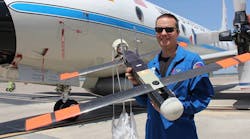The Coyote unmanned aerial vehicle (UAV) developed by Raytheon Co. was created for battlefield reconnaissance missions, but it has proven to be an invaluable aid to the National Oceanic and Atmospheric Administration (NOAA) in gathering information on storms during hurricane season. In fact, NOAA recently used six expendable Coyote UAVs for tracking and modeling the behavior of hurricane Maria. The aircraft (see photo) were launched from one of NOAA’s WP-3D Orion hurricane hunter aircraft and flew directly into the storm to gather data, including wind velocity, temperature, and air pressure.
Coyote UAVs are capable of being launched from the ground or from another aircraft. They can fly for as long as an hour and at distances as much as 50 miles from the host aircraft. “Raytheon technology is enabling hurricane hunters to understand storm behavior in new and better ways,” said Dr. Thomas Bussing, Raytheon’s vice president of Advanced Missile Systems “Our expendable Coyote UAVs are delivering vital information about these potentially deadly storms—and that can help save lives.”
The battery-powered Coyote UAVs integrate a suite of electronic sensors for gathering storm data while flying into winds exceeding 100 mph. An infrared (IR) sensor can also measure the temperature of the sea surface above the story. The aircraft are rugged enough to fly throughput all parts of the storm (including the eye) to collect information about changing storm conditions in various locations throughout the storm.
“NOAA is investing in these unmanned aircraft and other technologies to increase weather observations designed to improve the accuracy of our hurricane forecasts,” said Dr. Joe Cione, NOAA hurricane researcher and chief scientist for the Coyote program. “The Coyotes collected critical, continuous observations in the lower part of the hurricane, an area impossible to reach with manned aircraft.”
The Coyote was originally developed for the U.S. Navy for maritime surveillance. NOAA has been using early-model Coyotes and upgraded versions for storm research since 2009, amassing a large database of information on different storm conditions to enhance the accuracy of its weather behavioral models.

